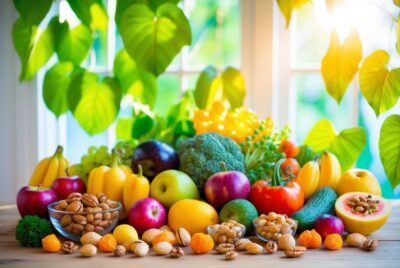Vegetarian Pizza: A Wholesome Delight
*We may earn a commission for purchases made using our links. Please see our disclosure to learn more.
Vegetarian Pizza Recipes: Easy and Delicious Homemade Options
Creating a vegetarian pizza is both an art and a science. I understand the importance of balancing flavors, textures, and freshness to transform simple ingredients into a mouthwatering meal. The foundation of any great pizza is its crust; whether it’s a whole wheat dough or a lighter alternative like flatbread or naan, the base needs to complement the array of vegetable toppings selected. Once the canvas is ready, the sauce—be it a traditional tomato base, a creamy garlic sauce, or even a pesto—acts as the flavorful adhesive for the toppings.

Selecting toppings for a vegetarian pizza is an adventure in the produce aisle. I always aim to include a variety of colors and tastes. Fresh options like spinach, sweet bell peppers, succulent mushrooms, or tangy artichokes can be used to not only create a visually appealing pie but also to ensure a fusion of vitamins and flavors. It’s also worth noting that the addition of cheeses such as mild mozzarella, tangy goat cheese, or salty feta can elevate the pizza with layers of texture and richness.
As a confident cook, I know that the final touch to the perfect vegetarian pizza requires a mastery of the cooking process. Vegetables need to be sliced uniformly for even cooking, and some might benefit from pre-roasting to deepen their flavors. The cooking method, whether it’s in a well-preheated oven or over the flames on a grill, is key to achieve a crispy crust with well-cooked veggies. Each step must be executed with care to ensure that the final product is a delightful combination of a crisp crust, a harmonious medley of vegetables, and melted cheese all in a single slice.
Essential Ingredients for Vegetarian Pizza

Creating the perfect vegetarian pizza revolves around a harmonious blend of cheeses, a rainbow of fresh vegetables, and a foundation of excellent dough and crust. What I choose and how I pair ingredients determines the pizza’s final flavor and texture.
Choosing the Right Cheese
For cheese, mozzarella is my go-to for its classic melt and mild flavor that complements rather than overpowers the vegetables. I often mix it with sharper cheeses like cheddar for complexity, or sprinkle Parmesan for a salty bite. It’s important to use fresh mozzarella that’s been well-drained to prevent a soggy pizza.
- Mozzarella: Mild, creamy, perfect for melting
- Parmesan: Adds a salty, umami flavor
- Cheddar: Sharp taste for depth (optional)
- Other options: Feta, goat cheese, smoked gouda
Selecting Fresh Vegetables
I handpick vegetables for their freshness and flavor. Tomatoes are a must for their juicy sweetness, and I love adding bell peppers and red onions for a crunchy contrast. Mushrooms lend an earthy taste, while spinach provides a subtle bitterness that balances the overall flavor. I often garnish with basil for its aromatic lift and include artichokes for their tender texture.
- Tomatoes: Sweet and juicy
- Bell Peppers: Sweet or slightly bitter, crunchy
- Mushrooms: Earthy flavor
- Spinach: Slightly bitter, works well with cheeses
- Olives: Bring brininess and richness
- Red Onions and Garlic: For sharp, distinct flavors
- Artichokes: Tender and mild
Pizza Dough and Crust Essentials
My crust choice is as crucial as my toppings. I prefer a dough that’s hand-stretched for an authentic texture — crisp on the outside, chewy on the inside. The dough should contain high-quality olive oil for a hint of richness and a golden hue once baked. Pre-heating the oven to a high temperature is vital for that perfect crust.
- Dough: Hand-stretched or rolled, should be supple and not overworked
- Olive Oil: For flavor and a crisp texture
- Preheat oven to at least 425°F (220°C)
- Optional: Spread a thin layer of pesto for a herby, rich base.
Steps to Crafting the Perfect Vegetarian Pizza

Creating a vegetarian pizza at home can be a delightful and rewarding experience. I’ll walk you through crafting the perfect vegetarian pizza, from homemade dough to baking the pizza to perfection, ensuring each bite is packed with your favorite veggies and flavors.
Preparing the Pizza Dough
Ingredients:
- 2 cups all-purpose flour
- 1 tsp salt
- 3/4 cup lukewarm water
- 1 tbsp olive oil
- 1 tsp active dry yeast
- In a large bowl, I combine flour and salt.
- I dissolve the yeast in lukewarm water and let it activate for about 5 minutes.
- Gradually, I add the yeast mixture to the flour, mixing until a rough dough forms.
- I knead the dough on a floured surface for approximately 10 minutes until it’s smooth and elastic.
- I then coat the dough ball with olive oil, cover it with a damp cloth, and let it rise until it doubles in size, usually about 1 hour.
Topping with Ingredients
Base Ingredients:
- Pizza sauce (tomato sauce or marinara sauce)
- Mozzarella cheese, shredded
Veggie Toppings:
- Sliced onions
- Chopped bell peppers
- Fresh spinach
- Roasted red peppers
- Sliced mushrooms
- Cherry tomatoes, halved
- Once the dough has risen, I press it onto a pizza stone or a baking sheet, creating a crust with a 1/2 inch border.
- I spread a thin layer of pizza sauce, leaving the border uncovered.
- I sprinkle a generous amount of mozzarella cheese over the sauce.
- Then, I add my chosen veggies, distributing them evenly over the cheese.
Baking the Pizza
- I preheat my oven to the highest setting, typically around 475°F or 250°C.
- I bake the pizza for about 12-15 minutes or until the crust turns golden and the cheese bubbles.
- I monitor the pizza and rotate it if needed to ensure even cooking.
By following these steps, I can craft a homemade vegetarian pizza that rivals the best pizzerias. The key is in the quality of the ingredients and the love put into the preparation.
Specialty Vegetarian Pizzas and Variations

Exploring the world of vegetarian pizzas, I find a wealth of varieties ranging from time-honored classics to innovative creations that offer a fresh take on this beloved dish. These variations not only cater to vegetarians but also invite any pizza enthusiast looking for a flavorful experience without meat.
World-Inspired Veggie Pizzas
One of the joys of vegetarian pizza is sampling the myriad flavors that global cuisines offer. I’ve savored Italian-inspired pizzas topped with sun-dried tomatoes and fresh basil, providing a tangy and aromatic profile. Artichoke hearts are another Mediterranean favorite, adding a unique texture and taste. In addition, Middle Eastern versions might include bold spices like Za’atar and a generous sprinkle of feta cheese, bringing a creamy balance to the mix.
- Italian Pesto Pizza: Pesto, artichoke hearts, black olives, sun-dried tomatoes.
- Middle Eastern Delight: Hummus spread, feta, red pepper flakes, topped with fresh arugula after baking.
Vegetarian Pizza Classics
The classics never go out of style. There’s something comforting and familiar about a pizza adorned with chunks of mozzarella and feta, slices of bell pepper, onions, and mushrooms. Each of these toppings contributes to a rich taste and satisfying texture. I make sure to use a variety of mushrooms, from cremini to portobello, to enhance the umami flavor that vegetarians often crave.
- Supreme Vegetarian: A base of tomato sauce, mozzarella, and feta with mushrooms, zucchini, bell peppers, and onions.
- Margherita: A simple yet elegant combination of tomato, slices of mozzarella, and fresh basil leaves.
Innovative Vegetarian Pizza Concepts
In the pursuit of something new and exciting, I’ve noticed a trend in innovative vegetarian pizza concepts. Vegan pizzas make use of dairy-free cheese and meat substitutes, while other contemporary recipes incorporate unexpected ingredients for a modern twist. For instance, the addition of charcoal to the dough gives the pizza an intriguing appearance and subtle smokiness.
- Charcoal Four-Cheese Margherita: Charcoal-infused crust with a blend of four cheeses.
- Sweet and Savory Fusion: A dessert-like pizza featuring a butter-brushed crust, spread with chocolate hazelnut Nutella, and topped with banana and strawberry slices.
Every specialty veggie pizza offers a unique experience, honoring traditional flavors or embracing new and inventive ideas that challenge the conventional pizza profile. Whether it’s a hearty, cheese-laden bite or a lighter, salad-topped slice, vegetarian pizzas can stand proudly beside their meaty counterparts.
Homemade Pizza Essentials

When I make pizza at home, the right tools and techniques are crucial. Not only do they streamline the cooking process, but they also elevate the quality of the final product, mimicking the results of a professional pizzeria.
Pizza Stones and Peels
Pizza stones are essential for achieving that pizzeria-style crisp crust at home. The stone’s porous nature absorbs moisture from the dough, ensuring a crispy bottom. I always preheat my oven to around 500°F (260°C) with the stone inside for at least 30 minutes to an hour before baking. As for transferring the pizza, a pizza peel comes in handy. I sprinkle it with a little cornmeal to prevent the dough from sticking and to add a slight crunch to the base.
Cooking Techniques
Uniformly cooking a homemade pizza requires the right technique. I often use the upper third of the oven where it’s hottest, which assists in crisping the crust and melting the cheese perfectly. For those using a pizza stone, preheating it properly is key, and for others using a sheet pan, I recommend a temperature around 425°F (220°C) to ensure the dough cooks through without burning the toppings. Adding a dash of garlic powder on top can enhance the flavors without overpowering them.
Perfecting Pizza Dough at Home
The heart of any pizza is the dough. For my homemade pizza dough, I focus on creating a balanced dough that’s neither too wet nor too dry. The quality of the flour is also important; I use bread flour for its high protein content, which leads to better gluten development and a chewier crust. After mixing, the dough must rest and rise—it’s an indispensable step for that light, airy texture. I also offer nutritional information for those who are health-conscious, ensuring my homemade pizzas are a delightful experience on pizza night.
Serving and Enjoying Vegetarian Pizza

When I serve my vegetarian pizza, my primary focus is on highlighting the fresh flavors and diverse textures. To start, I ensure that the pizza is sliced on a sturdy cutting board with a sharp pizza cutter, which helps maintain the integrity of the toppings. I prefer cutting the pizza into wedges, as it’s easy for guests to handle and enjoy.
For a Balanced Meal:
I often pair my pizza with greens to round out the meal. A crisp green salad or an arugula salad works wonderfully as an appetizer or a side. I dress the greens simply with balsamic vinaigrette to complement the richness of the pizza.
Topping Considerations:
- Fresh Basil: A sprinkle of freshly torn basil leaves over the pizza after baking brings a bright and herbal finish.
- Black Olives: Scattering sliced black olives on top adds a nice salty contrast to the other vegetable toppings.
For Leftover Pizza:
I find that leftover slices can be a delightful lunch the next day. Some people enjoy them cold, but a quick reheat in the oven can revive the pizza’s original texture and warmth.
Delivery Tips:
If I’m opting for delivery, I request the pizza to be well-done. It ensures that the crust is crispy and can support the weight of the abundant veggies without becoming soggy.
| Serving Suggestions | Why It Works |
| Cut into wedges | Easy to handle and serve |
| Pair with a green salad | Offers a fresh counterbalance |
| Fresh basil and black olives | Enhances flavor with fresh and salty notes |
| Enjoy leftover pizza cold | Convenient and still delicious |
By respecting the ingredients and considering these serving tips, I can confidently say that enjoying a vegetarian pizza is both a delicious and satisfying experience.
Frequently Asked Questions
I’ve gathered some common inquiries about vegetarian pizza, with answers aimed at enhancing your understanding and aiding in your culinary adventure.
1. What are the most popular toppings for a vegetarian pizza?
Bell peppers, onions, mushrooms, olives, and tomatoes are among the most popular toppings. These ingredients add a rich flavor and colorful presentation to vegetarian pizzas.
2. Can you suggest a simple vegetarian pizza recipe for beginners?
Start with a pre-baked pizza crust. Mix cream cheese, mayonnaise, and ranch dressing for the base. Add a generous layer of your favorite raw veggies like shredded carrots and diced peppers. Chill to let the flavors blend.
3. How can I find the closest place that serves vegetarian pizza?
Using a search engine or food delivery apps is effective. Simply input your location and search for vegetarian pizza options in your area. Check reviews to ensure quality.
4. What are some authentic Italian toppings for a vegetarian pizza?
Authentic Italian toppings include sun-dried tomatoes, artichokes, roasted garlic, capers, and arugula. Using fresh mozzarella cheese will also give it an authentic Italian touch.
5. What combinations of toppings work best for a gourmet vegetarian pizza?
Pairing earthy mushrooms with tangy goat cheese, sweet caramelized onions, and robust spinach can create a gourmet experience. Drizzle with balsamic glaze for a finishing touch.




